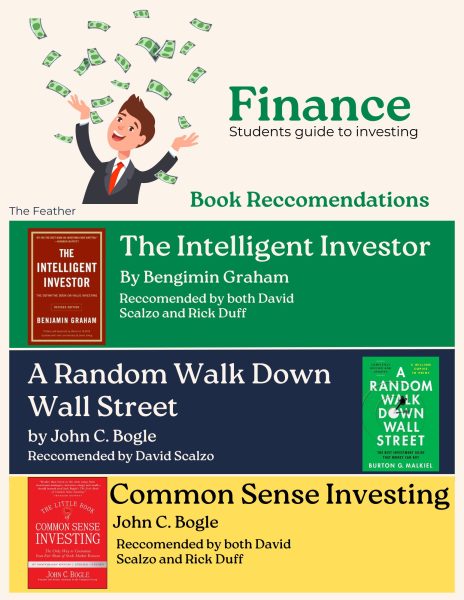A Student Guide To Investing
Many students shy away from investing their money because it seems complicated. Consistency is the key to successful investing.
Hypothetically–twenty-five years ago–two average people started with a one-time investment of $1,000. The first person put the money into a safe stock in the market (called an Index fund) and never thought about it again. The money accumulates interest.
The second person chose to be an active investor, paying attention to the market and researching the stock exchange in hopes of achieving consistent gains. However, the second man, despite his efforts, traded away his money quickly.
The truth about the Stock Market is that the average person will never be able to make consistent profits while trading daily. Only the top 1-20% of the best day traders will ever make a livable wage through active trading, while most lose all their money within the first 300 days and quit trading for good.
Students should know that simplicity is the enemy. You don’t have to come in guns blazing and chasing big returns.
Over the past 95 years, the largest assortment of stocks has gone up 10.3% per year on average. In simpler terms, if a person were to make an initial investment of 500 dollars and follow up with an additional 10 dollars a month, the initial investment would increase threefold within 5 years.
This can be proved with the use of compound interest calculators, which are helpful tools to visualize the degree a person’s savings could grow by investing in a single mutual fund that has, on average, gone up 10.3% every year since 1927.
Compound Interest Calculator | Investor.gov
As a student, you will need a few things to make an account on any investment site. If you are under 18, first and foremost, you are required to have parental permission. Once you have permission, you need personal information such as your Social Security number, legal name, date of birth, and any other official government-issued documents, such as your license, passport, etc. Then you can begin the process of making an account and diving into the world of investing.
Market Research

The basics of market analysis are being able to research the stock exchange and find companies to invest in. Alumnus David Scalzo, a financial advisor with the Global Wealth Management Division of Morgan Stanley in Fresno, perfectly sums up the baby steps of understanding market analysis.
“For a student new to investing, I would focus on learning the company’s health by analyzing its earnings, revenue, debt and other financial ratios,” Scalzo said. “This is called Fundamental Analysis.”
Basic market analysis can be accomplished by looking up any public company’s earnings report. For example, if you’re looking at Nike, just look up Nike earnings report in your browser and all the financial information on the company can be found.
Fundamental Analysis is not the only way to understand the market; Technical Analysis is the act of studying price charts.
“Technical Analysis is the act of studying price charts, volume trends and common indicators like moving averages and relative strength index to understand price movements and market sentiment.”
Rick Duff, a wealth manager from Los Angeles with more than 60 years of experience in the field, encourages youth to simplify the process. Duff gives some tips on what students need to take into consideration before deciding to take part in investing:
- Evaluate your psychology.
- Have a plan.
- Prioritize good quality long-term stocks.
“The market is a sewing machine; they’re always trying to serve you and help you,” Duff said. “I would say, based on extensive reading and research, know your risk tolerance and don’t day trade.”
Newsletters
Scalzo encourages all investors, including students, to pay attention to market news through online publications like Bloomberg, Reuters and CNBC. There are various “newsletters” that provide information about the market. Some newsletters are available at no extra cost, others may charge a subscription fee. These sites are a way to keep you on your toes and updated in the market happenings through various 3rd party sources.
Duff recommends Keith Fitz-Gerald, Investor Place and Invest Tech.
For all sites, it’s important to pick a newsletter that applies to your particular field of interest and keeps you accountable in the areas you lack.
Mentors are the quickest way to learn about investing and avoid mistakes. The chance to learn from a person who has made previous mistakes is an invaluable opportunity. Find someone who has experience and can teach you how to avoid making the same mistakes as they have made. Try and meet with them regularly to not only talk about the market but also evaluate your psychology.
Black Swan Events
At any moment, things can change within the stock market. Duff, in his 60 years immersed in the stock market, has seen the highs and lows and recognizes that spontaneous events nicknamed “black swans” may occur.
“The black swan is an out-of-the-blue event that you can’t have anticipated or planned for, it just suddenly happens, covertly,” Duff said.
The risk of investing cannot be avoided. No matter how much market research you do, no matter how much money or power you have, or the loophole you find, you will never get every single trade right. The market is not controlled by the companies, but by the people who assign value to the companies.
Companies revealing earnings reports greatly impact a stock’s price, but the earner’s report does not buy or short the stock. It is the people investing who decide whether the earnings report is good or bad, that then controls the stock price. The stock market is controlled by the people investing in it, not the companies themselves.
Must-read books:
Scalzo recommends:
- “‘The Intelligent Investor‘ by Benjamin Graham. This classic book introduces the
principles of value investing and emphasizes the importance of long-term, disciplined investing.”
- “‘A Random Walk Down Wall Street‘ by Burton G. Malkiel. This book explains how markets work, covering.”
both traditional investing strategies and the basics of behavioral finance.”
- “‘The Little Book of Common Sense Investing‘ by John C. Bogle. Written by the founder of Vanguard, this book is a guide to the power of index investing. It emphasizes a low-cost, long-term approach, making it a great resource for students who want to learn how to grow their wealth gradually without excessive risk.”
Rick Duff recommends:
- “‘Common Sense Investing’ by John Bogle John Templeton, another great, great investor.”
- “Books by Buffett. Reading Warren Buffett’s annual reports of the big meetings that he has every year. His newsletter goes out to all of his investors of the all-time great books.”
- “If you’re analytical, or the analytical type of person, is Ben Graham, Benjamin Graham, The Intelligent Investor. And that’s sort of Warren Buffet’s bible.”
The average age for people to start investing is between 32-35, according to MSN. Just by reading this article as a student, you’re putting yourself years ahead of the average investor. Don’t overcomplicate investing, it can be simple and doesn’t require hours of monotonous effort to make big returns. By taking advantage of concepts like compound interest and index funds, you can make consistent returns that will set you up for success in your later years.
To read more from The Feather, visit Athlete spotlight: Aden Millwee overcomes challenges to soar and A Student’s Guide to Saving.









Lala • Apr 2, 2025 at 10:31 am
Good Info, Maddy!